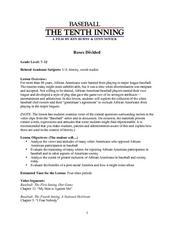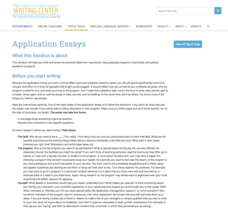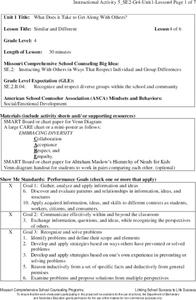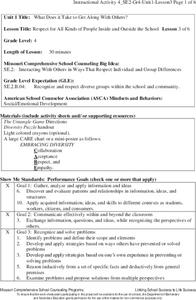Curated OER
Acceptance Sampling
In this algebra lesson, learners sample food and identify acceptance sampling. They create specific plans to meet specific situations as they sample the food. There are 6 questions.
Peace Corps
Brief Encounters
How are Pandyas different than Chispas? Explore cultural norms and societal behaviors with an engaging role-play activity. Split into groups of two hypothetical cultural groups, the formal Pandyas and the sociable Chispas, and another...
Radford University
Big Future - How SAT Scores Play a Role in College Acceptance
Understanding the importance of SAT scores is as easy as ABC. A set of three statistics lessons teaches scholars about normal distributions, the Empirical Rule, and z-scores. They apply their newfound knowledge to investigate data...
Museum of Disability
Rolling Along
Kindness and empathy can be as important as reading comprehension skills, especially for younger learners. Reinforce both with a lesson based on Rolling Along: The Story of Taylor and His Wheelchair by Jamee Riggio Heelan. As...
Museum of Disability
Can You Hear a Rainbow?
Teach your class about compassion and empathy with Jamee Riggio Heelan's Can You Hear a Rainbow? As kids read about Chris, a boy who is deaf, they discuss the things he likes to do, as well as the ways he communicates with the world.
Curated OER
October: Respect for Self and Others
Students realize their worth and dignity as human beings and account for their strengths as well as display their weaknesses. They display good manners and politeness, showing the respect for others as they would wish for themselves....
Curated OER
CULTURAL ACCEPTANCE
Students witness first hand what it feels like to be discriminated against.
Curated OER
Maskerade, My Self, And No Other
Students examine themselves, discover their strong, positive attributes, and recognize areas in need of improvement (since each individual possesses strengths but all people have some weaknesses). They develop self-acceptance, trust in...
Curated OER
Have Minorities Gained Acceptance
Students cite evidence gathered from magazines about how much Blacks are accepted into the mainstream of American life. They support their conclusions by writing an answer to an essay question.
PBS
Baseball: The Tenth Inning - Bases Divided
Baseball is a relatively high-interest topic through which social studies classes can explore racial prejudice in the US. Video clips provide much of the background information that groups record on their handout and then share with the...
Curated OER
Helping Others
Teach the skills, phrases, and responses necessary to help another person. Your autistic learner will practice specific phrases and responses in simulated situations where an adult or peer needs assistance. The exercise includes helpful...
Curated OER
Acceptance Through Patchwork
Students are asked to look at differences in people and accept those differences but to examine that people are more alike than different. The lesson has the central focus of investigating diversity.
Curated OER
Self Acceptance
Students develop confidence about themselves. Students imagine they are a rubber ball and think about how strong they are inside themselves. They read a story about an elephant and a lion and reflect on questions provided. Finally,...
Curated OER
Navajo Pottery: Beautiful Objects
Young potters make their very own version of the classic Navajo Pottery. With helpful worksheets and applicable cross-curricular activities, the lesson is an enriching way to mold both your clay and the multicultural...
University of New Mexico
Educating Culturally and Linguistically Diverse Students
Three mini units make up one large unit designed to explore multiculturalism and encourage cultural identity. Each lesson sparks thoughtful discussion, critical thinking, and are equipped with activities and assignments geared to...
Curated OER
Let There Be Peace: Nobel Prize Winners
What is the Nobel Peace Prize? After they establish criteria for great leadership, secondary learners read a New York Times article about President Jimmy Carter's acceptance of the Nobel Peace Prize in 2002. Individuals research the...
Missouri Department of Elementary
A Stranger Among Us
The final lesson in the R.E.S.PE.C.T series asks eighth graders to expand their vision beyond the walls of the classroom and to consider how they can promote acceptance and respect of others within in the global community. "A Stranger...
Curated OER
Self Acceptance
Students explore their own self concept. They draw a picture of themselves, read a story, and write a story that has a character like themselves. Afterward, they write and illustrate their stories in PowerPoint.
University of North Carolina
Application Essays
There's a lot riding on good writing! Often, an application essay is the difference between acceptance and rejection. As part of a series on specific writing assignments and contexts, a handout helps scholars craft the perfect personal...
Curated OER
Prejudice and Discrimination
How do we break the habit of prejudice? The activities in this packet are designed to promote awareness, harmony, and acceptance. Participants identify their stereotypic beliefs, attitudes, and behaviors, reflect to discover the sources...
Penguin Books
Wonder in the Classroom
Would you rather be right, or would you rather be kind? A novel unit based on R.J. Palacio's Wonder focuses on the need to be kind to others and to accept their differences. As learners read the book, they discuss the themes of...
Council for the Curriculum, Examinations and Assessment
Feelings and Emotions
Eighth graders express their emotions with a set of activities about self reflection and feelings. With a set of emotion cards and a worksheet that details negative thought patterns, the resource empowers young learners to discover and...
Missouri Department of Elementary
Similar and Different
Using a Venn diagram, pupils compare the similarities and differences between two classmates. Next, they review the CARE acronym (Collaboration, Acceptance, Respect, Empathy) and discuss how it applies to diversity in the classroom.
Missouri Department of Elementary
Respect for All Kinds of People Inside and Outside the School
Why is it important to embrace diversity? Scholars explore the topic by learning about the CARE acronym: Collaboration, Acceptance, Respect, Empathy. They also complete a diversity puzzle worksheet and play a collaborative game that...

























